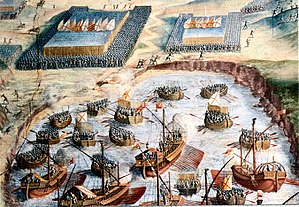
Back احتلال جزر الأزور Arabic Conquista española de las Azores Spanish Conquista delle Azzorre Italian Batalha da ilha Terceira Portuguese
| Conquest of the Azores | |||||||
|---|---|---|---|---|---|---|---|
| Part of the War of the Portuguese Succession | |||||||
 The Spanish Tercios landing on Terceira (July, 1583).Painting at: El Escorial Hall of Battles. | |||||||
| |||||||
| Belligerents | |||||||
|
|
| ||||||
| Commanders and leaders | |||||||
|
|
| ||||||
| Strength | |||||||
|
9,200 men[5] 30 warships |
11,700 men[5] 96 warships | ||||||
| Casualties and losses | |||||||
|
9,000 dead or captured[6] (Mostly prisoners) 30 warships captured | 400 dead or wounded | ||||||
The Conquest of the Azores (also known as the Spanish conquest of the Azores),[6] but principally involving the conquest of the island of Terceira, occurred on 2 August 1583, in the Portuguese archipelago of the Azores, between forces loyal to the claimant D. António, Prior of Crato, supported by the French and English troops, and the Spanish and Portuguese forces loyal to King Philip II of Spain, commanded by the Admiral Don Álvaro de Bazán, Marquis of Santa Cruz, during the War of the Portuguese Succession.[6] The victory of the Marquis of Santa Cruz resulted in the rapid Spanish conquest of the Azores, facilitating the integration of the Kingdom of Portugal and its colonial possessions into the Spanish Empire.[4]
Following a day's fighting, forces of the island of Terceira were defeated by Spanish Tercios, using the strategies and tactics of Álvaro de Bazán.[7] A few days later, a contingent of Spanish-Portuguese troops landed on the island of Faial, where they defeated and captured a garrison of five French and one English company (700 men in total).[1] At the end of the campaign, approximately 9,000 Portuguese, French, Italian, and English were captured by the Spanish.[7] The French, English, and Italian soldiers on the islands were allowed to retire unharmed, but 16 supporters of the Portuguese claimant, António, Prior of Crato, who had attempted to flee on the night of the attack were executed: António and a few of his supporters were lucky to escape with their lives.[6]
- ^ a b Tenison. Elizabethan England. Leamington Spa. Volume IV. p.211–213. ISBN 1-84664-916-1
- ^ Geoffrey Parker (1999), p.73–74
- ^ Nascimiento Rodrigues/Tessaleno Devezas p.122
- ^ a b Black p.182
- ^ a b Konstam. The Armada Campaign (1588) p.44
- ^ a b c d Geoffrey Parker p.73
- ^ a b Cite error: The named reference
Parker p. 73was invoked but never defined (see the help page).